Pictures of Practice features Endeavor educators who have excelled in their classrooms, districts, and regions by implementing pedagogical content knowledge, course-related resources, assignments, and projects initiated through Endeavor. Select a Picture of Practice below to read an example of excellent STEM education conducted by Endeavor educators.

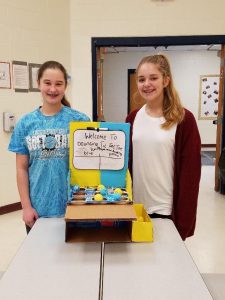
Audrey and Maya built a Bouncing Tic Tac Toe game that involved ramps, ball returns, and a mechanism to release the balls after each game. |
Janice Kane, Technology Integration/STEAM teacher in Nottingham, New Hampshire strives to make learning experiences more authentic by selecting engaging STEAM activities for all her students to experience learning in meaningful ways. In the past few years she reports a noticeable increase in the number of female students thriving in STEAM, “I’m finding that in 8th grade, the girls are the ones who are most motivated and interested in engineering, building, and design.” This exciting observation gives Ms. Kane hope that her work is part of a larger community of teachers working to provide excellent STEAM opportunities for all students, including young women.
Starting with her 1st grade students and developing the philosophy across 1st-8th grade students, Ms. Kane maintains that “can’t” is not an acceptable word in her classroom. Students can say “I am having trouble with or I need help with”, language that gives all students confidence that they are capable of problem solving, but all students hear that they are capable of design. This important aspect of classroom culture gives students the confidence they need to find solutions to challenges. She uses her own “imperfect” skills to demonstrate that everyone makes mistakes and that it’s okay to make mistakes because we learn from them, leading to the development of our own unique set of skills.
Ms. Kane shares that students are not graded on the beauty of their projects and tells them, “it’s about how much work you put into it. I want to see that you are really trying to solve problems.” She hopes she is giving her students confidence to keep trying, to persevere. “It may not work out quite the way they wanted it to, but as long as they explain what they did and why it didn’t work, they are learning.”
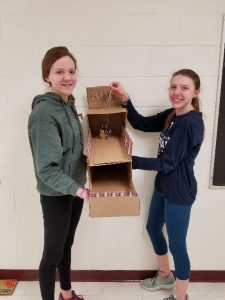
Hannah and Noelle built a mini bowling alley that involved ramps, ball returns, and a mechanism to reset the pins after each game. |
One terrific example of Ms. Kane’s student centered philosophy is her lesson inspired by Caine’s Arcade. A young boy in Los Angeles, California, creates arcade games while keeping busy at his father’s auto parts store on his summer break. When discovered by a friendly customer, his arcade games become a famous example of creativity, design and self-directed integrated STEAM learning. Ms. Kane uses Caine’s story as inspiration for an engineering design challenge that directly addresses NGSS performance expectations for engineering and science, and CCSS math practices.
Ms. Kane graduated from NASA Endeavor STEM Teaching Certificate Project and earned her Certificate in STEM Education sponsored by Teachers College Columbia University in Fall 2018. Her coursework included: Methods of STEM Education* [Grades PK-5], The E in STEM: Meaningful Content for Engineering, Coding, Robotics, and 1:1 Devices, The Arts in STEM: Advancing Meaningful Integration; and Practicum in STEM Leadership. During E in STEM: Meaningful Content for Engineering Ms. Kane designed a challenge which she calls the Airplane Project. She reports learning “a tremendous amount about the design process and engineering methods to use in the classroom” during the class, facilitated by Dr. Josh Brown, a veteran instructor for Endeavor.
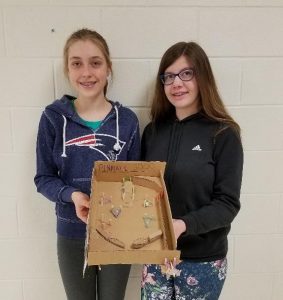
Audrey and Maya built a Bouncing Tic Tac Toe game that involved ramps, ball returns, and a mechanism to release the balls after each game. |
Ms. Kane is a big proponent of integrated STEAM education because of direct evidence she has of student learning in her classroom. Every day she sees the wonder, creativity and joy it brings to her students and is inspired by the lack of inhibition her students feel to create solutions. They each feel welcome to problem solve using their math, science, ELA, art, technology and engineering skills – a truly integrated environment for learning.

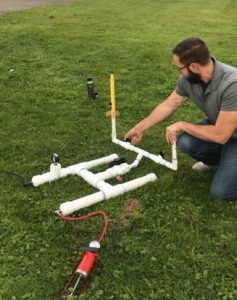
Charles Canestaro integrates authentic design challenges in his physics and chemistry courses at Cortland Senior High School in New York. As a participant in graduate level course, Physical Science in Motion, offered by the Endeavor STEM Teaching Certificate Project, Canestaro developed and implemented a lesson on rockets inspired by NASA’s Project Enterprise Activity.
Canestaro is the first recipient of the Glen Schuster Memorial Scholarship, established in honor Glen Schuster, founder of the Endeavor STEM Teaching Certificate Project, who supported the development of thousands of STEM educators nationally throughout his career. Canestaro received funding to participate in the three course Endeavor STEM Teaching Certificate program and is on track to earn a certificate in STEM Education from Teacher’s College, Columbia University in December 2018.
The rocket he is getting ready to launch in the picture was designed and built by students. He presented a scenario, challenging them to design and build the most aerodynamic rocket following specified constraints. Students followed a project schedule, role played tasks within a team, and justified a realistic project budget. Each team designed a rocket to scale, built it, tested it, and calculated terminal velocity to determine drag coefficients. Once launch day arrived, Canestaro’s students were excited and ready for lift off! Through the integration of AP calculus, physics, arts and design, and following NASA’s engineering design process, Canestaro believes he was able to enhance student learning through application of STEM teaching practices.
Canestaro started the program with Methods of STEM Education. He reflects, “I learned current research and trends in teaching STEM. I was blown away with the projects and discussions each week and came away with so much new knowledge and ideas that I would directly be able to implement in my class.” After his second course, The “E” in STEM: Meaningful Content for Engineering, he shared, “I not only learned how to incorporate engineering practices in my classroom, I was able to get my hands dirty and participate in numerous projects that incorporated the engineering design process.” Canestaro is current finishing his third course, Physical Science in Motion, selected by him from a suite of options.
Working in an NGSS state, Canestaro is as excited about his experience as his students are about rockets. “The program has supported me immensely in thinking about the NGSS as well as incorporating NASA research into my class. I cannot recommend this program enough to any educator looking to improve their craft, incorporate STEM in their classes, and/or transition their lessons to the new NGSS standards.” Canestaro will complete a STEM Leadership Project, the culmination of the ivy-league certificate program. His collaborative outlook on his profession is clear, “I have shared a ton of what I have learned with colleagues, which in turn has helped their practice. The program has also opened up a wonderful world of inquiry, research, and collaboration that I never knew about, through discussions in the online forums.”
Charles is exactly the type of teacher we hope to support at Endeavor, says Karen Woodruff, Project Director. “He is enthusiastic about STEM and dedicated to learning how to engage students in meaningful analysis of authentic, real-world data. We look forward to welcoming the next awardee of the Glen Schuster Scholarship in December.”
The application window for the 2019 Glen Schuster Memorial Scholarship is October 22 to November 24th. The winner will be announced on December 10th and will participate in the Spring 2019 cohort.

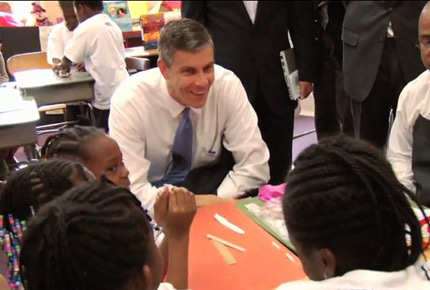
On Wednesday May 12, 2010, Arne Duncan, U.S. Secretary of Education, joined 3rd graders and NASA Endeavor Fellow Netosh Jones. At the Martin Luther King, Jr. Elementary School in Washington, D.C., Ms. Jones' students had a most interactive session about science and engineering in their classroom. Students presented their designs of "shock absorbers" that spacecraft need for landing on the Moon or Mars. The engineering activity led to a discussion about energy and friction as students assembled and tested model cars on various surfaces.
Ms. Jones, through Endeavor, has received extensive professional development in STEM. She facilitates engineering design challenges and science inquiry regularly with her students. Secretary Duncan, along with practicing engineers, spoke to students about careers in STEM fields. Students reported to the Secretary that building and design is a process that includes testing, lots of mistakes, corrections and "do-overs."
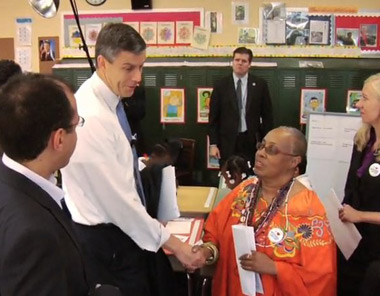
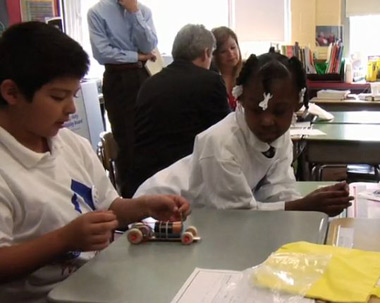
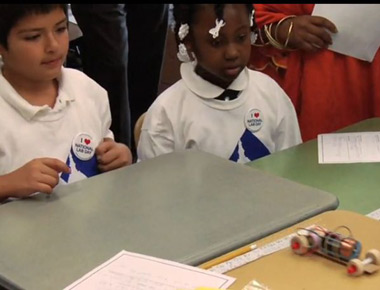
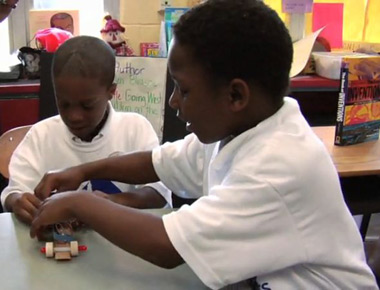

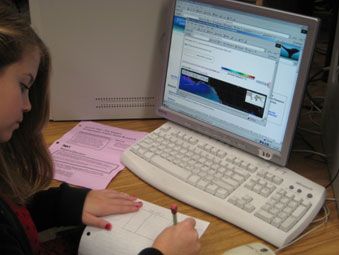 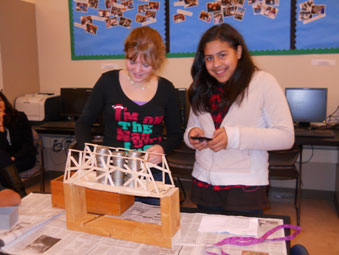 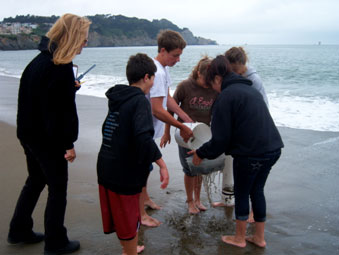 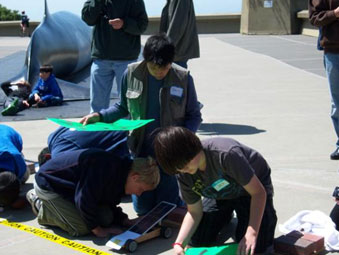 Ms. Schilling's students engaged in various STEM activities. |
Gina Schilling, a science teacher at Hill Middle School in Novato, California, first stumbled upon STEM teaching methods while participating in a 3-day workshop in the San Francisco Bay Area. U.S. Satellite Laboratory led the workshop and focused on one of its award-winning programs, Signals of Spring-ACES (Animals in Curriculum-based Ecosystem Studies). This standards and classroom based program teaches students about marine animal migration through different strands: biology, chemistry, Earth Science, math, geography, mapping and the environment.
Students collaborate in small groups. They develop process skills by designing models, conducting experiments, and creating tables and graphs. They interpret NASA data in expert groups. In Ms. Schilling's 7th grade classes, students used Earth imagery to make inferences to explain the movements of marine animals as the students tracked various species such as seals, seabirds, sea turtles, sharks and Polar Bears. Students interacted with scientists in their online Analysis Journals. She noted that students intuitively linked their understanding of animal migration to conservation by expressing how human actions on land impact marine animals out at sea.
She also provided enrichment opportunities in marine science outside of the classroom, including mole crab monitoring in San Francisco beaches, summer marine biology snorkeling trips in Florida's Key Largo and annual local Beach Cleanups. Through the implementation of this program and success in her class, she won a $5,000 grant from Best Buy to purchase five computers and a printer for her classroom. Ms. Schilling took advantage of Signals of Spring-ACES' unique approach to integrate STEM. It was popular with her students.
Her next STEM project involved physics and a desire to incorporate physics lessons on motion and speed with hands-on and real-world applications. As an extension for her gifted and talented education (GATE) students, she used her school's Study Hall period to help her students construct solar cars. As a result her students twice won 2nd place for the distance competition at the Junior Solar Sprint Challenge. This was sponsored by UC Berkeley's Society of Women Engineers at the Lawrence Hall of Science.
Then, there was a pending threat of her school's closure. Ms. Schilling was excited when her principal addressed the need for change to help save their school. The principal proposed they give their school a new focus and become a STEM magnet. Unfortunately, an informal focus group of parents rejected the strong focus on technology while teachers rejected the threat of additional work. Through her principal's encouragement, Ms. Schilling eagerly went ahead with their plan on a smaller scale. She was asked to begin a STEM-based elective to get some of the disadvantaged students in her school excited about learning.
She leveraged a project she worked on from Summer 2010. Ms. Schilling had been selected as one of four educators in Marin County to begin a MESA (Mathematics, Engineering, Science Achievement) program. She incorporated her work in her new elective. MESA is a 40-year-old program which was developed by UC Berkeley as a pre-college intervention to initiate more interest for their engineering department. MESA has expanded to junior high schools nationally and was featured in the PBS documentary "The Innovators" as a solution to developing the next generation of innovative engineers and scientists.
Her MESA elective consisted of twenty 7th graders, many of whom earned basic scores in their STAR tests, failing grades, truancy issues and received free or reduced lunches. Her students participated in STEM-based lessons and activities that culminated in individual or team projects. Her students competed against other schools in "MESA Days" at local universities. Culminating projects included Egg Drops, PopsicleTM Stick Bridges, Human Eye Models, Mousetrap Cars and Pre-Algebra and Speech competitions. Her students rose to the occasion and placed in every category at the preliminary competition. In addition, at a field trip to attend Great America's Physics, Science & Math Day, her students won 2nd place in the 2011 Cardboard Boat Race.
Soon, parents began inquiring how to transfer their children into Ms. Schilling's special course. She expanded MESA to two middle schools and one high school in her district. She was invited to join a local chapter of Cal-PASS, an initiative that collects, analyzes and shares data in order to track performance and improve success in elementary school through the university. Her local chapter organizes monthly "STEM Un-Conferences" which brings together math, science and technology teachers to promote collaboration and STEM professional development.
Ms. Schilling is working her learned Endeavor strategies for her students, but recognizes how the marine animal tracking program was a catalyst for reform and STEM implementation in her school and district. As a NASA Endeavor Fellow and an "Agent of Change", her ultimate goal is for her students to aspire to become scientists and engineers.
For 2011-2012 she joins Hamilton Meadow Park, a K-8 school where she will continue to teach Life and Physical Science and a STEM elective. Her goal is to utilize her training from Endeavor to make STEM teaching a reality in all of her classrooms. She has plans to initiate interaction with the elementary faculty to create a buddy science program with her middle school students and to include Family STEM Nights to spread the word about her applications to the curriculum.

 Kim Abegglen dressed in cleanroom equipment with her mentor, Dr. Charles Gatebe and project scientist at NASA's Goddard Space Flight Center (GSFC). 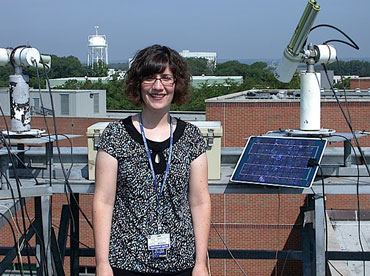 Rooftop equipment collects scientific data at GSFC |
"Every interaction I had on my first day with NASA Goddard scientists had an undercurrent of EXCITEMENT. They were excited by their questions and projects. They were excited to share their ideas, their knowledge and their experimental results. They were excited to be doing science!" reports Kim Abegglen when discussing her internship at NASA Goddard.
Ms. Abegglen, like other NASA Endeavor Fellows, was awarded a fantastic opportunity to spend two weeks at a NASA Center, this one at NASA's Goddard Space Flight Center in Greenbelt, Maryland. Her time at NASA was filled with so many interesting experiences that have blossomed into fantastic classroom activities, lasting content knowledge and valuable contacts. Integrating NASA content with concepts covered in the classroom has yielded some exciting classroom activities for her middle school students, but the experience itself was amazing.
"The moment I met my host, Dr. Gatebe, my learning experience began. Dr. Gatebe is a natural mentor and excellent teacher. As we entered the Earth Science Division, he got right to work explaining all that I was seeing—real-time data from satellites, information displayed in posters and interactive kiosks and model images from Landsat, ICESat and TERRA satellites."
Ms. Abegglen was immediately impressed by the scientific practices all around her. She interacted with scientists and their high school, undergraduate and graduate student interns. She examined data instruments including a Cloud Absorption Radiometer (CAR) and sun photometers. She had opportunities to ask colleagues questions as they shared their projects. She was astonished at their desire to communicate their investigations, results, frustrations and ideas for further consideration. This is what science is all about. Immersed in the scientific process during her time at NASA, she collaborated and shared problem-solving strategies. She read and studied about climate and evidence of climate change using interactive technology tools. Ms. Abegglen spent her first week interacting with members of the NASA project team and being oriented to Dr.Gatebe's project. Dr. Gatebe introduced her to many NASA specialists and encouraged her to take initiative and introduce herself to others.
"I was encouraged to tell them about what I do and why I am here at Goddard, and to ask them about what they do here at NASA. I was surprised that I spent much of my time at Goddard talking to and interviewing people. My understanding of scientific practices and Earth Science content knowledge increased significantly by these daily, on-going discussions."
In addition to conferencing with NASA team members, the Endeavor intern also spent time in the Radiometric Calibration Facility, learning from Dr. Gatebe, Rajesh Poudyal and John Cooper what the Cloud Absorption Radiometer (CAR) is and how it is calibrated. She had never been in a clean room laboratory before and was reminded of the importance of precision in measuring, the importance of patience in collecting data and that science is innovative. She was able to attend two conferences. The first "town hall" style conference was for NASA Goddard interns (high school and college) and featured keynote speaker Charlie Bolden, NASA's Chief Administrator. Equally inspiring, the keynote speakers of the second conference were the Atlantis STS-132 crew returning from their recent trip to the International Space Station.
After touring the Scientific Visualization Studio and the Visitor Center where the "Science on a Sphere" is housed she shared her impression, "These experiences have given me perspective of the role of education in furthering NASA's mission of engaging students and building their science and math confidence. When educators and communities are successful at achieving this goal, our students do not 'opt out' of STEM in school; STEM careers remain an option for their future."
Ms. Abegglen views her two weeks at NASA Goddard as "really the beginning of my NASA internship." From her experiences working with NASA team members, she developed curriculum for grades 5-8 entitled, "Self-Assessing Scientific Practices in an Integrated Science Context: The Sun is the Primary Source for Energy in Earth's Climate System." Students explore light, radiation, the Earth's Energy Budget, albedo and climate while self-identifying scientific practices. The main learning objective of her curriculum is to explore the Sun's critical role in global climate and to practice thoughtful scientific skills. Ms. Abegglen continued to collaborate with Dr. Gatebe as she field tested her three-week unit.
"I am very grateful to be a part of the NASA Endeavor Fellowship and for the opportunity this program provided me to be mentored at NASA Goddard. I experienced the many practices of science all day, every day while I was there. My content knowledge and my ability to make that content knowledge accessible to students using NASA assets increased significantly. I was able to interact with NASA team members, an experience that would be so beneficial to all science educators. And, I believe I built relationships that can help to strengthen the partnership between education and professional scientists."

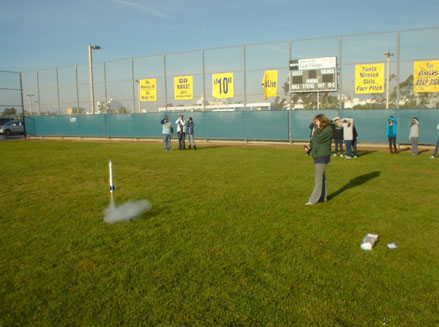 Mr. Weichman's students conducting a rocket launch. |
Joe Weichman and Steve Heck, NASA Endeavor teachers in two rather different classrooms, demonstrate success with diverse approaches to the same fascinating topic—Rocket Launches.
Mr. Weichman, a pre-service teacher conducting a STEM study with introductory algebra students at Santa Monica High School in California, used a rocket launch activity to demonstrate the relevancy of math in science. Through his work in Endeavor courses, Mr. Weichman developed activities that integrate math and science by linking algebra to rocketry. He believes that these connections help inspire students to choose STEM careers.
Mr. Weichman introduced his rocket unit with NASA videos of shuttle launches and future propulsion systems. With students, he conducted several rocket launches and finished up his unit with algebra problems that used data directly from the launches themselves. His problem set was developed using the "5E" method, a versatile and highly effective instructional tool for engaging students in a variety of learning modes. Mr. Weichman reports, "Students were continually asking when we could launch more rockets. One student discussed the desire to start his own rocket club."
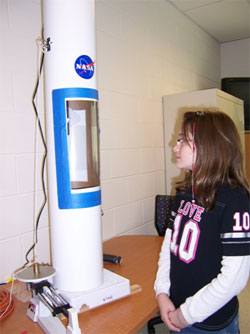 Fifth grade student in Mr. Heck's class testing a model in the wind tunnel. |
Similarly, Mr. Heck, a 5th grade teacher at the Mulberry Elementary School in Ohio, now has 4th grade classes excited and looking forward to participating in his Mulberry Rockets Design Process as 5th graders. While immersed in Endeavor's course Physical Science in Motion: Classroom Applications, Mr. Heck developed a set of rocketry lessons, focused on the Engineering Design Process, using "inspiring" NASA resources and teacher guides.
He started rocketry by assigning teams of four students an engineering challenge—the design of a next generation spacecraft for astronauts. Mr. Heck's fifth graders used NASA reference materials, videos, and especially NASA-designed applets to develop their concepts during the Research and Possible Solutions phases of the Engineering Design Process. Students drew scale models of their solution and requested materials to construct their models to test. To further enhance the unit, Mr. Heck built a NASA-designed wind tunnel for student use during the design process. "I thought it would be great for students to design, test, redesign and then fly their rockets."
Mr. Heck reports, "The actual testing in the wind tunnel was outstanding. The need to test and evaluate models was clear, and to my amazement, over 80% of my students went back to the drawing board to change, correct, or adjust some portion of their model. Of course, the highlight of the lesson was Launch Day. Each team presented their flight-ready model and launched it for the class. It was a great day in STEM Education. My superintendent and principal were amazed at what my 5th graders accomplished."
Through informal feedback Mr. Weichman determined that his students were successful in making connections between math and rocketry, and have a greater appreciation and understanding of how math is intertwined in society. Students in Mr. Heck's class were equally inspired as they began discussing additional phases for the unit which has blossomed to include an art component, as well as a corporate component where students write professional letters requesting employment as engineers.
Now a NASA Endeavor Alumnus, Mr. Weichman is certain that his Endeavor experience was highly relevant to his future. "Many of the things I learned from going through this program will be permanently integrated into both my teaching strategies and the development of a new charter high school that will emphasize STEM."
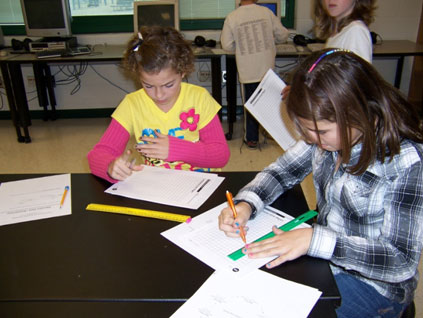 Mr. Heck's students engaged in the Engineering Design Process. |

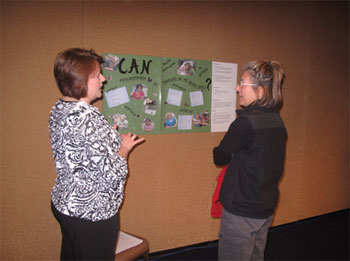 Angie Brown discusses her research with another conference attendee at the Association for Science Teacher Education (ASTE). 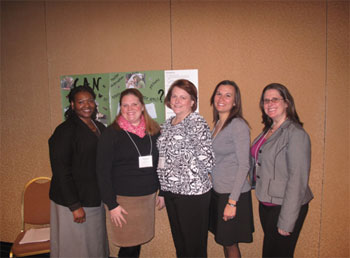 NASA Endeavor instructors share the spotlight with Ms. Brown (center). (left to right): Dr. Felicia Moore Mensah, Dr. Jessica Riccio, Angie Brown, Dr. Amanda Gunning and Dr. Meghan Marrero. |
Angie Brown, now a NASA Endeavor Alumna from Cohort 1 at the Gibbon Elementary School in Nebraska, often wondered what made students, girls especially, scream, recoil in fear, or not participate during classroom activities that involved insects. Ms. Brown has never been afraid of these creatures herself, and actually has always found them quite fascinating!
"When I thought about it, I remembered my mother (and father) taking me out to the Platte River, or into our pasture and looking for all sorts of creatures, insects included", Ms. Brown explained. "So, I wondered if maybe girls are conditioned by their mother's behavior to be afraid of insects and other creatures."
Ms. Brown decided to dedicate part of her NASA Endeavor Action Research Project to the fear of insects, entomophobia, in her 4th grade girls and see if it could be reversed in the classroom setting. Her interest in science inquiry and methodologies learned from her work in Endeavor courses set the stage.
She began her study by conducting a survey of all her students in both fourth grade science classes. Ms. Brown asked questions of her students such as: "How do you feel about insects?" or "How do you feel about turtles?", and "How does your mother feel about insects?" She also asked how students' fathers felt about insects. She found that in every case, the girls that indicated a dislike or fear of insects also had mothers who were afraid of these creatures.
Next, she collected data on three girls who indicated the greatest fear. Each of them was interviewed further about their fears. Their responses were recorded. Then, as part of the plan, the entire class learned about three different types of insects, including their eating habits and life cycles. The insects were at first introduced to the students in closed petri dishes, so that they could be viewed without direct contact. Later, when the last insect species was introduced, live Madagascar Hissing Cockroaches, the students were allowed to handle them. Ms. Brown invited a female entomologist to speak to her students about various insect species in Nebraska. The guest scientists brought a variety of species for students to handle, including some non-insect species such as a Giant Millipede.
Throughout their focus study on insects, all of Ms. Brown's students completed journals about their experiences during class. Each day they recorded what they did in class, and how they felt about it. As time went on, the three test subjects indicated that they were becoming less and less scared of insects and at the end of the study, the three female test subjects were interviewed about their experiences. Two out of the three indicated that they were no longer afraid of insects. They indicated what they did in class changed their mind about insects. The third indicated she changed her mind about her fear, but she did not believe it had anything to do with the class activities.
In January 2011, Ms. Brown presented her research with a poster presentation during the national Association for Science Teacher Education (ASTE) Conference. She fielded questions from college professors from all over the country. She reflects, "It was a great experience and a great opportunity for me to highlight my research."
NASA Endeavor Fellows have the opportunity to perform action research on an aspect of their classroom practice to see if some of what they are introducing in the classroom is effective. By gathering some data and exploring each Fellow's interest, some fascinating results can emerge.

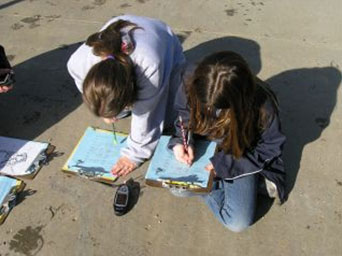 Students engaged in the culminating geocaching activity included in Ms. Gabrovic's GPS Unit. |
Julie Gabrovic's work as a NASA Endeavor Fellow Alumna and Science Lab teacher at Wekiva Elementary School in Longwood Florida, is a model for excellence in collaborating with peers when it relates to STEM learning. She sets the bar when it comes to bridging content in and between classrooms in her school for deeper understandings and ultimate learning experiences for students. She created a "GPS Unit", a series of classroom lessons that integrates science and social studies (geography) themes, and incorporates technology as part of a collaboration with her colleague, Mr. Greg Prose, who teaches physical education.
Ms. Gabrovic believes her GPS Unit is cutting-edge and relevant for students because global positioning systems (GPS) are becoming so widely used in our everyday lives. "Most students have seen a GPS unit of some sort, whether in their car, on their cell phone or on television. However, the majority of them don't understand how they work and the wide scope of uses for GPS technology." Ms. Gabrovic's lessons are packed with authentic and meaningful information and activities including satellites, Earth rotation and revolution, longitude and latitude, elevation, and map reading - content featured in several NASA Endeavor courses. "My experience with the NASA Endeavor courses has given me so many resources which have allowed me to create and implement many new and exciting programs and curricular units. In particular, the online sharing with other cohorts of Endeavor Fellows and each course's resource pages have been instrumental."
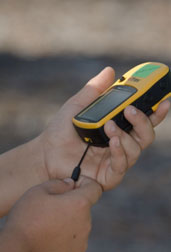 Hand-held GPS device used by students throughout the GPS Unit. |
Ms. Gabrovic started her teaching career as a physical education teacher. She has enjoyed sharing and integrating STEM ideas with her fellow teachers. Activities are planned together, culminating with a physical education lesson where students complete an actual geocaching and fitness course around their school campus. After the successful writing and implemention of the GPS Unit, Ms. Gabrovic, along with the physical education department and gifted teachers at her school, were awarded a grant to purchase additional handheld GPS units. They plan to expand the GPS work in the school.
In addition to circumnavigating her campus with students, Ms. Gabrovic sought out an additional collaborative opportunity by creating a Science Club. She wanted to embark on a NASA Engineering Design Challenge after learning about them in her work with Endeavor. Her 4th grade afterschool Science Club launched their first design challenge. They focused on Bottle Rockets. Each team was challenged to build one that would reach higher and straighter than their competition. Teaming with technology teacher, Mrs. Karyn Cook, students created Animoto videos, a Web 2.0 tool, to share the experience during a Parent Showcase. The videos documented the students' learning process throughout the stages of the Engineering Design Challenge.
Ms. Gabrovic used part of her Endeavor stipend to purchase two Flip digital video cameras so her students could record and share their work. Each NASA Endeavor Fellow receives a stipend for a needed resource or technology tool for his or her classroom in order to enhance the ability to integrate STEM successfully.
Ms. Gabrovic continues to take advantage of NASA Endeavor's offerings and looks forward to her Summer 2011 Endeavor Internship at NASA Goddard. She is partnering with the Seminole State College Planetarium and director Derek Demeter in the development of Earth and Space assets for the planetarium, a place she hopes to soon visit with her students.
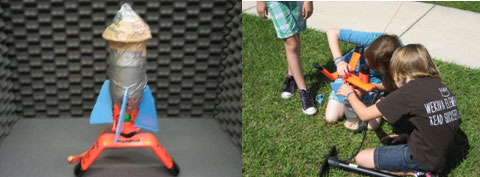 Left: A bottle rocket created by 4th grade Science Club students. Right: Students getting ready to launch their rocket. |

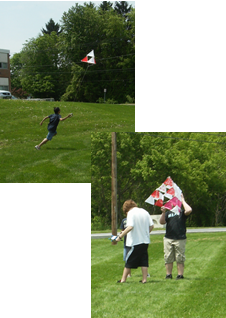
Mrs. Lisa Waldman, National Board Certified Teacher at East Pennsboro High School in Enola, PA uses NASA resources to excite her students about integrating mathematics and science while incorporating technology. She makes learning mathematics come to life with real world applications in each class. She also enjoys incorporating engineering lessons that she gained as a NASA Endeavor Fellow when applicable to the curriculum.
Kite Building. Students in Mrs. Waldman's Honors Geometry class applied their knowledge of similar figures, surface area and volume while creating tetrahedron kites. They began the project by researching the historical significance of kites while designing their own models of them in learning groups. Using NASA's Kite Simulator they discussed effects of wind and drag on their kites as they changed in size. After creating their first tetrahedron cells they placed four of them together to create a group kite. At each phase, the groups tested their kite and calculated the surface area, volume, and maximum altitude after measuring the angle of elevation. They incorporated their knowledge of 2 and 3D figures to determine the effects on the larger class scale models. To conclude the project they discussed and designed future kites.
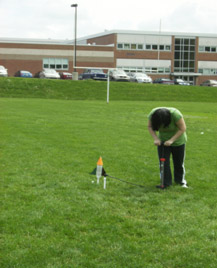
Rocket Launching. In her algebra class, students explored Newton's Laws and the effects of wind and gravity while studying quadratic equations by launching both air and water rockets. Using the knowledge and resources she gained from NASA Endeavor's course, Physical Science in Motion, the students began their research with the NASA Rocket Modeler created by the Glenn Research Center to determine the most efficient materials and designs. After creating their models, the students launched their rockets outside on a football field. They timed their flights, drew parabolic flight paths, calculated the approximate distanced traveled, and acceleration. They also used clinometers to measure the angle of elevation and used trigonometric tables to solve the ratios she provided to calculate the maximum height of the rocket. They then compared those answers to common quadratic height equations found in most textbooks
h= -1/2 at2 +v1t + h1.
Applied Mathematics. In a Math Topics course Mrs. Waldman integrated various topics of Earth Science such as global warming, ocean acidification and ocean dynamics in a beach erosion study. While students enhanced their understanding about coastlines and oceans they applied mathematical skills of graphing, writing equations of lines and curves, and analyzing properties of trigonometric waves. Student calculated various statistics to determine the most cost effective preservation strategy for their adopted beach and wildlife. They also learned and discussed the natural process of how the coastlines were formed mathematically with the study of fractals. In order to make this unit more hands-on and meaningful to the students, Mrs. Waldman used various NASA satellite images to view carbon dioxide, phytoplankton pigment concentration, ocean salinity, and tide gauge data from NOAA.
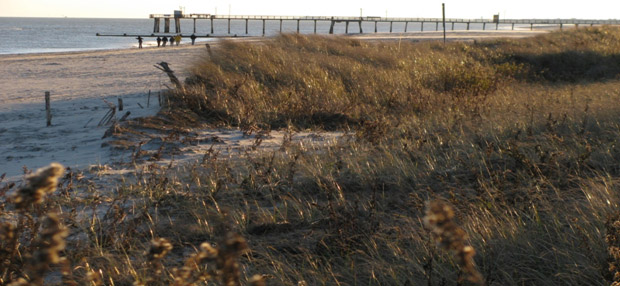
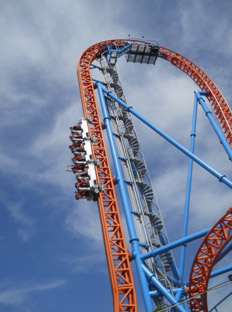
She is currently looking forward to using a data collection device created by Vernier, purchased with a grant from both NASA Endeavor and the East Pennsboro Education Foundation, with the school's Math Club for an upcoming trip to a local amusement park, Hershey Park. In this fun filled day, the students will be collecting data from various rides to generate graphs and answer questions related to math, physics, and statistics.
Mrs. Waldman continues to seek new and interesting ways to integrate subject areas across STEM and make math meaningfuland exciting for students. She remains involved as a NASA Endeavor Graduate, serving as a mentor to math teachers and to fellows seeking National Board Certification.

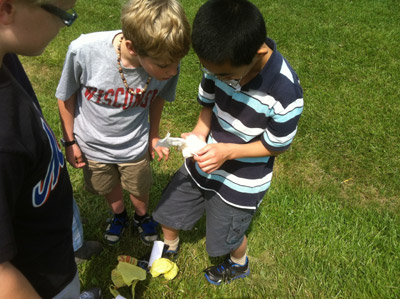
Geoff Bergen, Technology & Engineering Educator at Whisconier Middle School in Brookfield, Connecticut, has been challenging students with unique engineering design activities since 2006. Students have worked on a number of projects. They have designed and constructed a 42-foot long cable-stayed bridge in the back of the school; studied Newton's Laws of Motion and aerodynamics while racing model Land Speed Record Vehicles; and even designed and constructed several custom electric guitars. Mr. Bergen's Technology & Engineering program has only become more rigorous and STEM oriented since he became a NASA Endeavor Fellow.
Mr. Bergen created a special new curricular unit and engineering design activity as part of his Endeavor coursework. The unit focuses on physics content while engaging his students in an engineering design challenge. Sixth and seventh grade students take on the challenge of designing a new heavy lift rocket for NASA, over the course of a 30 day rotation. Students must design, construct, test and evaluate a model rocket capable of carrying a raw egg to a minimum altitude of 200 feet and returning it safely to the ground!
The activity begins with students generating a list of what they know about rockets and a list of questions they have about rockets or the design challenge. One question always gets asked, "How do we know how high the rocket goes?" Mr. Bergen displays questions on post-it-notes in a common area in the classroom. In small groups, students consider one of the questions and research its answer on their own. They use online NASA resources and report their findings to the class at the beginning of each class meeting.
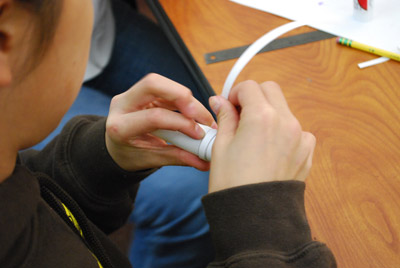
Student groups develop a company name and logo which identifies them and their rocket. Mr. Bergen uses the logos to make replica NASA badges for each student group, adding to the realism of the activity. The engineering challenge is broken down into a few mini-challenges to get students working right out of the box. The first is the egg-drop activity. Students use one class period to design/construct their solution and a second class session to test and evaluate the performance of their solution. Students keep a design journal which documents the entire engineering design challenge.
Students design their rocket based on some basic design guidelines and in consultation with Mr. Bergen. Next, they build their rockets from scratch using directions from Mr. Bergen, tutorial videos, and other online resources. Students construct their rockets from simple materials: cardstock, copy paper, cardboard, hot glue, recycled shopping bags, etc. After some decorating and final preparations, launch day arrives.
Students really enjoy seeing their efforts pay off when the rockets launch towards the heavens. The rockets reach varied altitudes, based on the design and construction. Mr. Bergen allows students to use multiple motors to power their rockets which really adds to the challenge of engineering. They learn the fine balance between what is required and what they want to achieve. Using a Launch Altitude Tracker, available from NASA's Rockets Educator Guide, they calculate the altitude reached by their rocket.
The Heavy Lift Engineering Design Challenge is a successful activity for several reasons. Foremost, students really look forward to coming to Mr. Bergen's Technology & Engineering Education class. They learn new and challenging physics content while being involved in a hands-on engineering challenge. "It's been a great addition to the program and I owe it all to my NASA Endeavor experience," says Mr. Bergen.
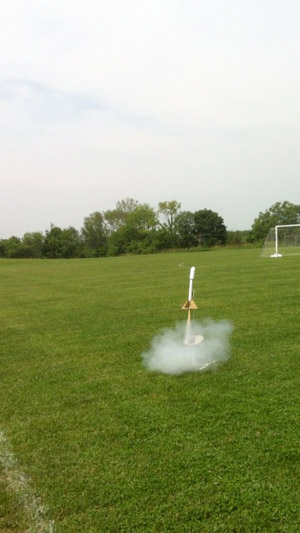
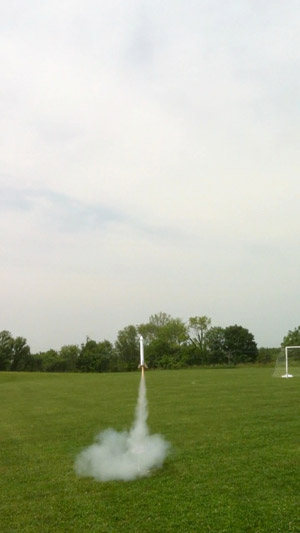

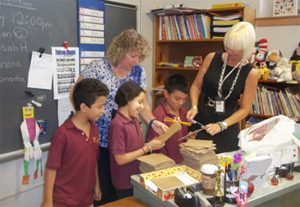 Donna Gallo and Roseanne Torre hand out cardboard "chassis and wheels" provided by the Robert Karp Container Company. 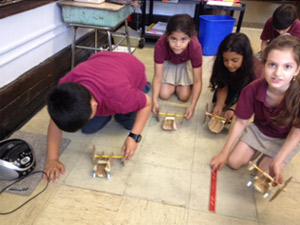 These students at Horace Mann School measure the success of their rovers to move six inches and a foot. 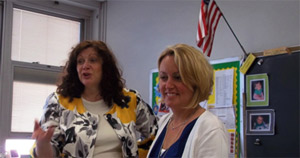 Endeavor Fellow, Stephanie Stern (left) with third grade teacher Jen King talking to Ms. King's class about the importance of science and engineering in their futures. 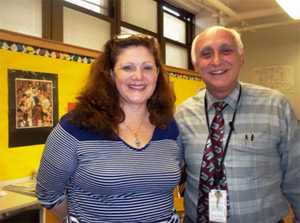 Stephanie Stern, Endeavor Fellow, and Al Orlando, District Supervisor of Science 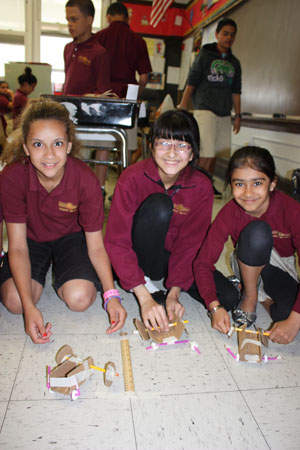 Fourth grade students in Ms. Bright's class work proudly on their moon rovers. |
Stephanie Stern, NASA Endeavor Fellow, is an integral part of Engineering Success across the North Bergen School District, NJ.
Fifty North Bergen's third and fourth grade teachers teamed up in Spring 2012 with NASA Endeavor Fellow, Stephanie Stern, to help students understand more about STEM (Science, Technology, Engineering and Math), by designing and building moon rovers.
Under the progressive direction of Bob Dandorph, North Bergen's superintendent, Nick Sacco; Assistant Superintendent, Janet Sandstrom; Director of Language Arts; and Dr. George Solter, Director of Mathematics, Al Orlando, the district's Science Supervisor put together a cross-curricular, week-long unit, dedicated to delivering "multiple subjects under a central theme" across the school district.
Mr. Orlando teamed up with Ms. Stern, who is the computer teacher at Franklin School, in order to plan a multiple-subject unit. The NASA Rover "STEM-venture" gives students a chance to learn in a project-based setting with hands-on alternatives to paper and pencil testing. Ms. Stern was successful earlier in the year with another lesson activity at Franklin School (covered by the North Bergen Reporter in January).
Mr. Dandorph and his team presented a challenge to Mr. Orlando and Ms. Stern to offer a truly-cross-curricular platform. Not only did students have to learn the basics of STEM content, they also had to add Language Arts and History components.
Mr. Orlando and Ms. Stern took the challenge and ran. "Stephanie built the multi-curricular project by starting with a non-fiction reading and with a comprehension piece. It had historical facts about how the original moon rover was conceived and built by NASA," explained Mr. Orlando. "The STEM-based project included elements from our four core curriculum areas. All were delivered by centering on the NASA Design Squad building of a Lunar Rover." In addition, Ms. Stern used the Engineering and Design Method from Engineering is Elementary to discuss how the engineering process could be used to solve challenges in other subject Areas.
"When I took the NASA Endeavor course, "E in STEM: Meaningful Content for Engineering," explained Ms.Stern, "I learned that engineering in the classroom is an incredibly engaging way to teach an entire array of concepts." Ms. Stern's experience was immediately put to use on a fourth grade group at Franklin School. "We started with the Moon Lander, and discovered how well engineering design works at the elementary level. It is thanks to NASA Endeavor that made this success possible."
Through a team effort, Ms. Stern and Mr. Orlando coordinated the necessary supplies, including a massive amount of cardboard that was used to make panels for over 1,400 rovers. They provided each teacher from the district's schools with a special building supply kit.
After all of the kits and handouts were put together, Ms. Stern and Mr. Orlando delivered professional development to the 50 teachers across the district. As part of Ms. Stern's Endeavor Leadership Seminar course, she was challenged to deliver professional development at the district level. The teachers subsequently learned about the engineering design process and each built a rover in Ms. Stern's computer lab. "The teachers really took hold of the project and definitely supported the effort," stated Peter Clark, principal of Franklin School, and the district's Curriculum Specialist. "Cross-curricular learning is one of the best ways to reach students of different interests, and get them working together to solve problems."
So how did the students like their Rover Mission? Jen King, a third grade teacher at Kennedy School, said that her students loved the whole project. "We added some video feed of the rover from NASA's website and PBS' Design Squad. The students watched how scientists engineered designs and were mesmerized."
Stephanie Roes, a fourth grade teacher at Robert Fulton School said that her students really liked learning how things are put together. They liked how they were able to make the rovers and then record and make changes in their designs as they went along.
Participating teachers responded enthusiastically by sending Stern and Orlando a list of what they would like to add to future projects. "I really appreciated the feedback, considering it's a big undertaking for any team of educators," Ms. Stern said. "Going forward, I hope to help build these units to cover even more grades and get more students excited about their possible futures in science and engineering. This is a core teaching of NASA Endeavor Fellows, and has had very positive results here in North Bergen. Everyone wins - especially the students."
